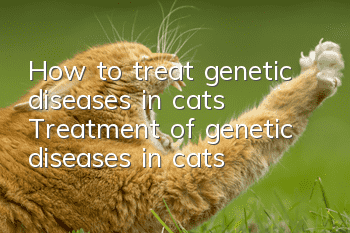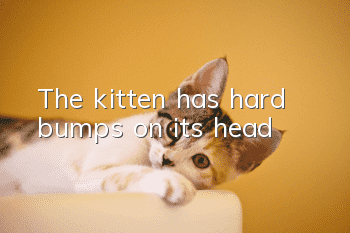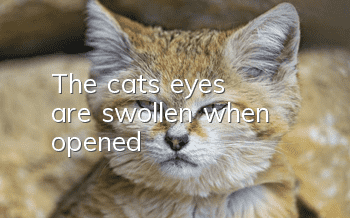How to treat genetic diseases in cats? Treatment of genetic diseases in cats!

Cats with folded ears have congenital cartilage defects
How to treat genetic diseases in cats? Treatment of genetic diseases in cats! Genetic diseases are caused by some congenital causes, and differences in genes will cause different Genetic diseases, some genetic defects, mutations can lead to genetic diseases. At the same time, for cats, different breeds can also cause different genetic diseases. Genetic diseases will not show up when cats are young. Generally, the period of high incidence of genetic diseases is between one and three years old.
Different breeds of cats have different genetic diseases. Generally, purebred cats have a high probability of getting genetic diseases, so don’t always think that purebred cats are good, have noble blood, and are a symbol of status and status. Of course, , this is one aspect, but they may have genetic diseases, and many of them are difficult to treat, so this is also a problem in the choice of cats.
Let’s take a brief look at the genetic diseases of cats. Persian cats have polycystic kidney disease, which causes kidney failure, and there are also inevitable respiratory problems and tear gland problems caused by special short nasal tubes. We also know that the cartilage of the cat with folded ears is a problem, so the ears fold down. As long as the cat with folded ears carries the folded ear gene, including folded ears and erect ears, whether it is folded ears with folded ears, folded ears with British short ears, or Both cats with folded ears and short ears have genetic bone diseases, abnormal cartilage and bone development, which are unpredictable. Cats with folded ears may also have heart problems and are prone to cardiac hypertrophy. Bobtail cats are prone to cardiovascular diseases, especially male shorthair cats in the United States, which are most susceptible to cardiac diseases. Once the disease occurs, there is a risk of sudden death. Finally, let’s look at Siamese cats, which are prone to renal failure, eye problems, mucopolysaccharidosis VI, mesenteric tumors, allergic bronchitis (asthma), fertility difficulties, stillbirth, lymphoma, etc. In addition, the skeleton of modern Siamese The pelvis and tail are especially prone to skeletal problems. Siamese pelvic problems are prone to problems, but they are generally not life-threatening. What's more frightening is that the frame is too narrow and long, resulting in a too small chest, which suppresses the organs in the chest, leading to various organ problems, which can become fatal factors.
When it comes to genetic diseases, treatments are limited and require careful consideration. Some are structural deformities that can be corrected surgically, such as cryptorchidism, hernias, and permanent arterial or venous catheters. In some cases, there is a deficiency of proteins, cofactors, substrates, or metabolites, and the deficiency can be corrected by supplementation. Adding pancreatic enzymes and injecting insulin can be used for exocrine and endocrine pancreatic insufficiency respectively. Excessive bleeding caused by hereditary coagulopathy and (von) Willebrand's disease can be treated using fresh plasma. Other enzyme and protein replacement treatments are also in progress.
Kidney transplantation has been used in animals with chronic kidney failure, but it has not yet been applied to genetic kidney diseases in young animals. Several genetic disorders of hematopoietic cells, such as defects in hematopoiesis and interleukin-2 receptors, resulting in pyruvate kinase and fructose phosphokinase deficiencies, have been treated with bone marrow transplantation. Bone marrow transplantation has also been tried to treat lysosomal storage diseases of functional cells, or activated proteins, and other tissues, such as liver, bone, and brain. nowIn research on gene therapy, functional genes are implanted into the defective cells of sick animals. This research has been successful in rodents and needs to be further applied in cats.
Secondly, prevention is also an important factor. In order to reduce the occurrence of genetic diseases and eliminate genetic defects, as well as the spread of mutant genes, the focus is on preventing genetic diseases in familial or pure breed animals, that is, anyone suffering from Animals with genetic diseases should not be used as breeding animals. This method is a simple and effective way to eliminate animals with dominant genetic diseases. However, there are still some shortcomings in the elimination of animals with recessive genetic diseases, but it can reduce the prevalence of defects in certain breeds or kittens. However, this approach may seriously reduce the genetic diversity of the breed. Actually detecting carriers (heterozygotes) and true non-carriers (homozygotes normal) is the key. In advanced countries, it is easy to identify carriers of autosomal (carried by both parents) and X-linked recessive (carried by the mother) genetic disorders. As mentioned above, for some diseases reliable carrier detection tests are useful. Animal breeders should undergo scans to detect genetic diseases before breeding animals. But they are often afraid that the test results will be released to the public and damage their business, so animal doctors should educate them. If you want to change a narrow gene and obtain multiple desired characteristics, carrier animals can be mated with homozygous normal animals for breeding, but the offspring must be tested. Only animals with normal tests can be used as breeding animals.
We don’t need to pay too much attention to the issue of genetic diseases, but we shouldn’t take it lightly. Nowadays, there are not many true purebred cats. In communities, most of the cats raised at home are born from crosses, and those with genetic diseases The probability is greatly reduced. Secondly, for purebred cats, symptoms of real life-threatening genetic diseases are rare in real life. Some good feeding and care by the owner can also reduce the probability of genetic diseases.
- How big can a Ragdoll cat grow?
- How soon can a kitten be bathed?
- How to groom a Persian cat effectively? Are you raising it correctly?
- How to clean the eyes of pet cats?
- How to train a timid and fearful cat? The most important thing is to be familiar with the environment
- How should you deal with a disobedient cat? It’s because your method of training the cat is useless!
- Can kittens eat eggs?
- How to relieve a cat’s heat?
- Can cats have rabies? Cats have symptoms of rabies!
- Why does my cat keep having diarrhea?



